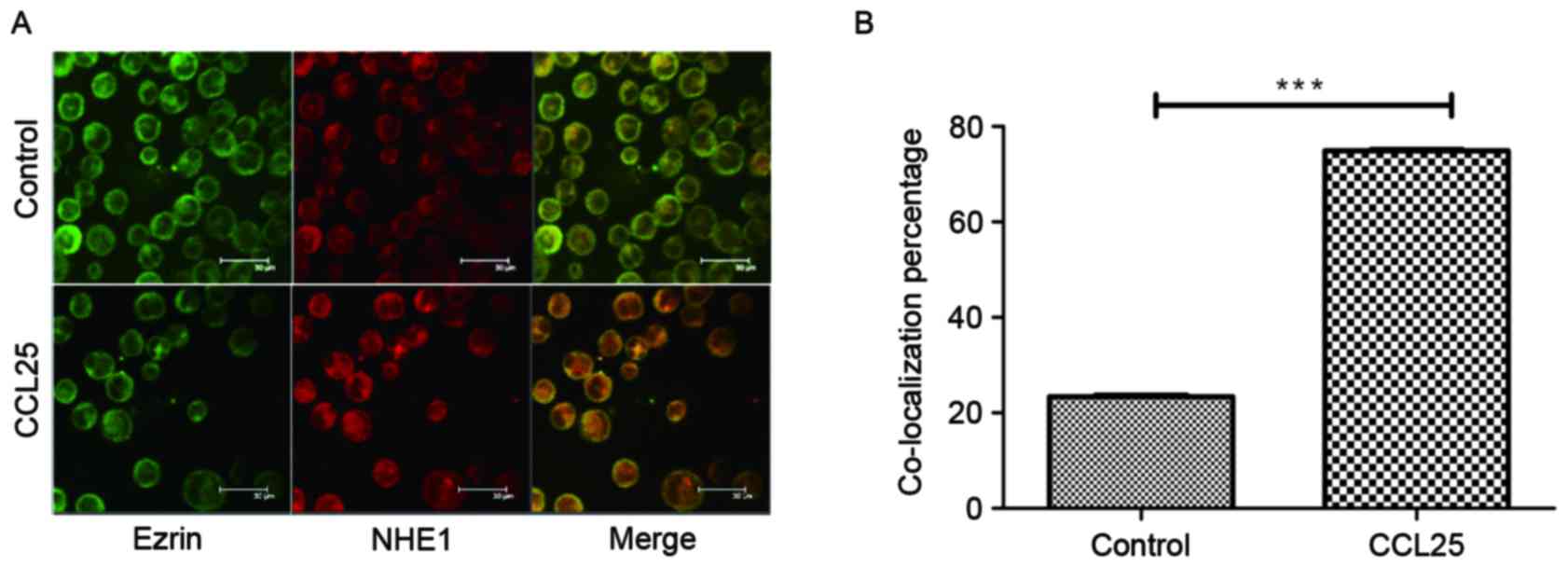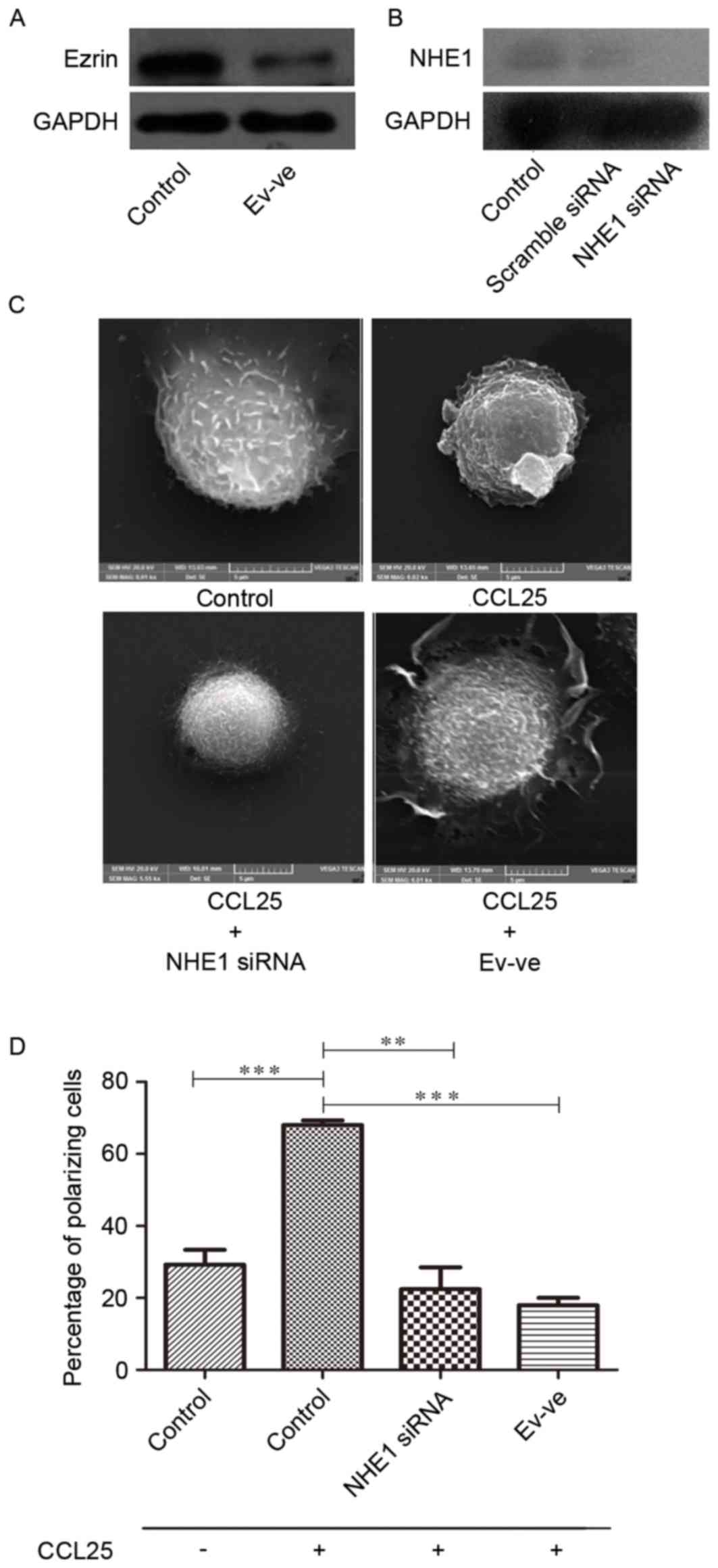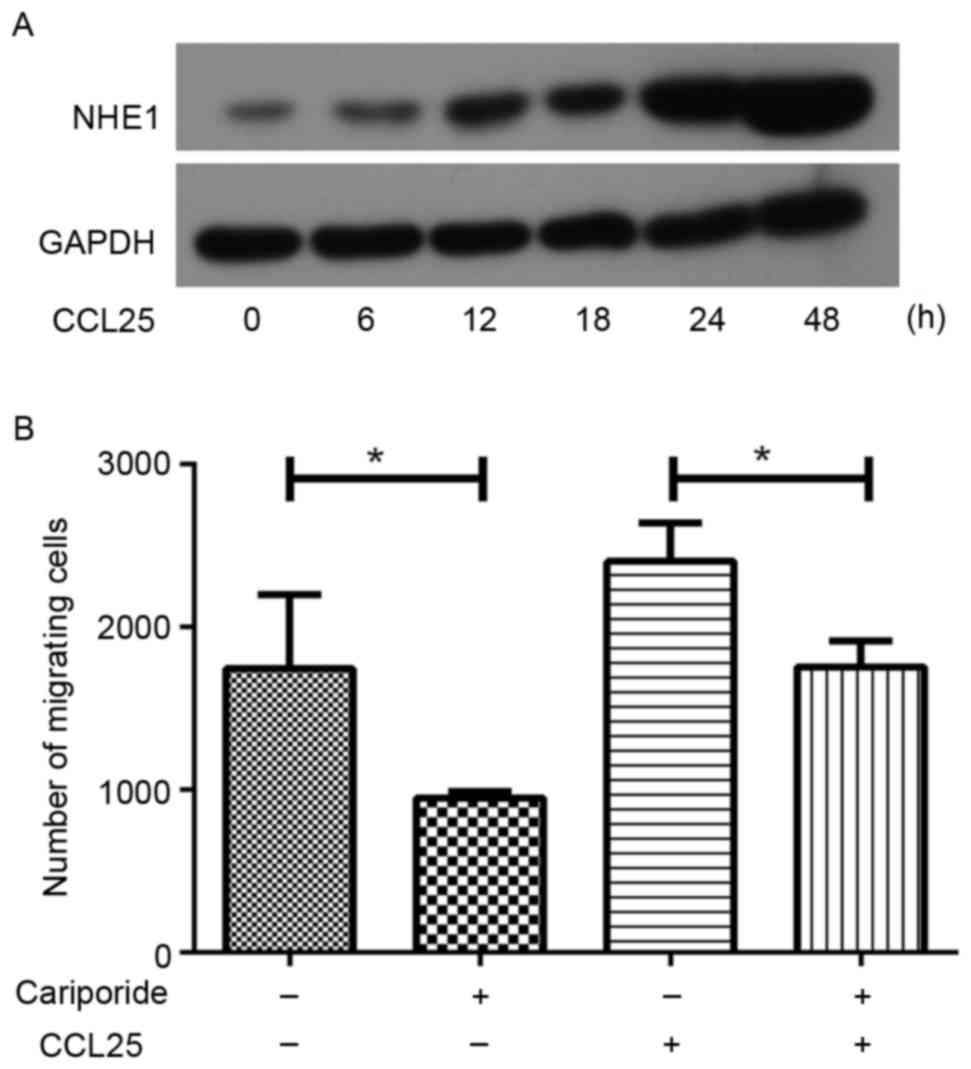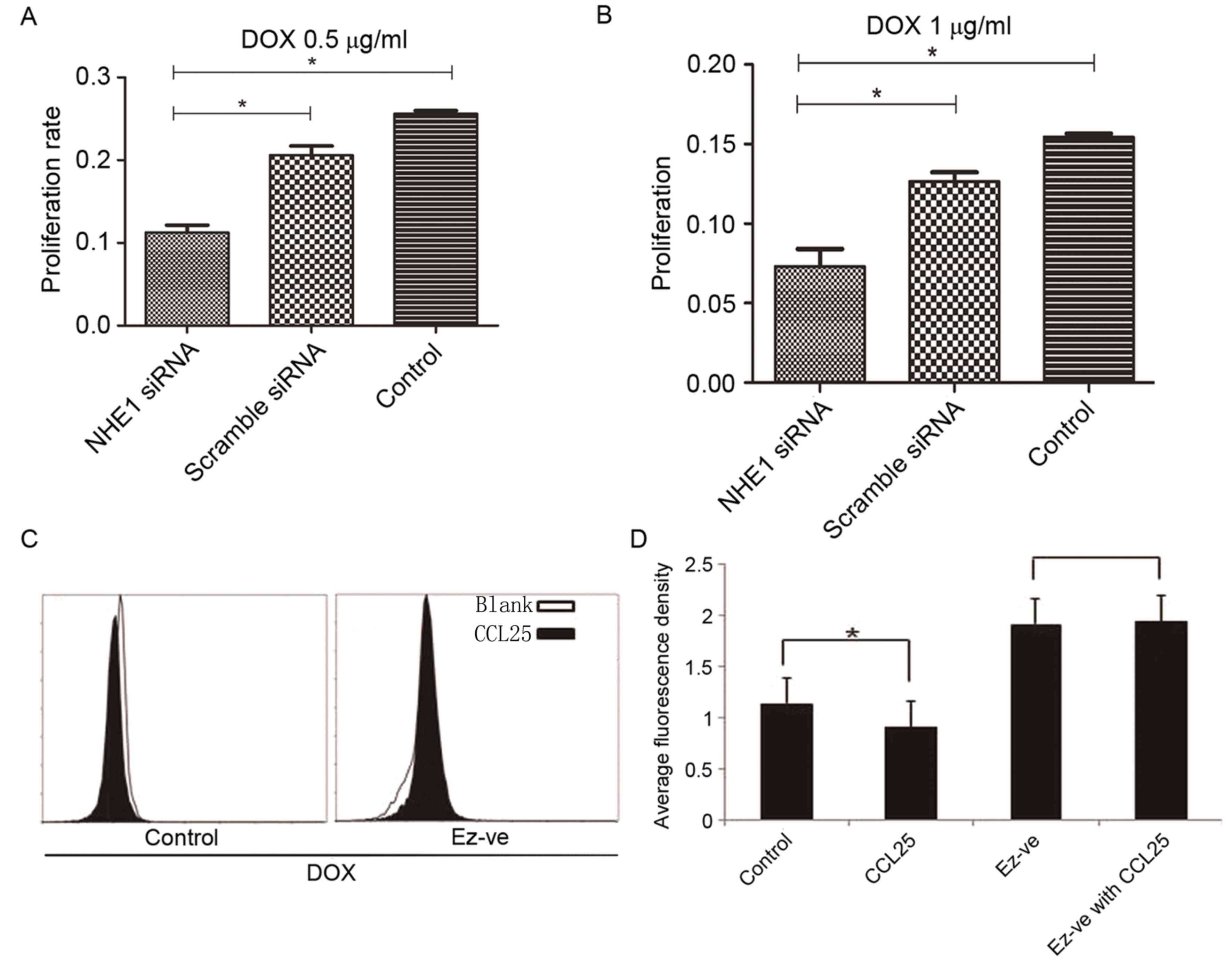|
1
|
Gómez AM, Martínez C, González M, Luque A,
Melen GJ, Martínez J, Hortelano S, Lassaletta Á, Madero L and
Ramírez M: Chemokines and relapses in childhood acute lymphoblastic
leukemia: A role in migration and in resistance to antileukemic
drugs. Blood Cells Mol Dis. 55:220–227. 2015. View Article : Google Scholar : PubMed/NCBI
|
|
2
|
Pitt LA, Tikhonova AN, Hu H, Trimarchi T,
King B, Gong Y, Sanchez-Martin M, Tsirigos A, Littman DR, Ferrando
AA, et al: CXCL12-producing vascular endothelial niches control
acute T cell leukemia maintenance. Cancer Cell. 27:755–768. 2015.
View Article : Google Scholar : PubMed/NCBI
|
|
3
|
Man CH, Lam SS, Sun MK, Chow HC, Gill H,
Kwong YL and Leung AY: A novel tescalcin-sodium/hydrogen exchange
axis underlying sorafenib resistance in FLT3-ITD+ AML. Blood.
123:2530–2539. 2014. View Article : Google Scholar : PubMed/NCBI
|
|
4
|
Amith SR and Fliegel L: Regulation of the
Na+/H+ exchanger (NHE1) in breast cancer metastasis. Cancer Res.
73:1259–1264. 2013.
Slepkov ER, Rainey JK, Li X, Liu Y, Cheng FJ,
Lindhout DA, Sykes BD and Fliegel L: Structural and functional
characterization of transmembrane segment IV of the NHE1 isoform of
the Na+/H+ exchanger. J Biol Chem 280: 17863–17872, 2005.
View Article : Google Scholar : PubMed/NCBI
|
|
5
|
Orlowski J and Grinstein S: Diversity of
the mammalian sodium/proton exchanger SLC9 gene family. Pflugers
Arch. 447:549–565. 2004. View Article : Google Scholar : PubMed/NCBI
|
|
6
|
Antelmi E, Cardone RA, Greco MR, Rubino R,
Di Sole F, Martino NA, Casavola V, Carcangiu M, Moro L and Reshkin
SJ: ß1 integrin binding phosphorylates ezrin at T567 to activate a
lipid raft signalsome driving invadopodia activity and invasion.
PLoS One. 8:e751132013. View Article : Google Scholar : PubMed/NCBI
|
|
7
|
Lin Y, Wang J, Jin W, Wang L, Li H, Ma L,
Li Q and Pang T: NHE1 mediates migration and invasion of HeLa cells
via regulating the expression and localization of MT1-MMP. Cell
Biochem Funct. 30:41–46. 2012. View
Article : Google Scholar : PubMed/NCBI
|
|
8
|
Denker SP, Huang DC, Orlowski J, Furthmayr
H and Barber DL: Direct binding of the Na-H exchanger NHE1 to ERM
proteins regulates the cortical cytoskeleton and cell shape
independently of H(+) translocation. Mol Cell. 6:1425–1436. 2000.
View Article : Google Scholar : PubMed/NCBI
|
|
9
|
Chiang Y, Chou CY, Hsu KF, Huang YF and
Shen MR: EGF upregulates Na+/H+ exchanger NHE1 by
post-translational regulation that is important for cervical cancer
cell invasiveness. J Cell Physiol. 214:810–819. 2008. View Article : Google Scholar : PubMed/NCBI
|
|
10
|
Cong D, Zhu W, Shi Y, Pointer KB, Clark
PA, Shen H, Kuo JS, Hu S and Sun D: Upregulation of NHE1 protein
expression enables glioblastoma cells to escape TMZ-mediated
toxicity via increased H+ extrusion, cell migration and
survival. Carcinogenesis. 35:2014–2024. 2014. View Article : Google Scholar : PubMed/NCBI
|
|
11
|
Zhou B, Leng J, Hu M, Zhang L, Wang Z, Liu
D, Tong X, Yu B, Hu Y, Deng C, et al: Ezrin is a key molecule in
the metastasis of MOLT4 cells induced by CCL25/CCR9. Leuk Res.
34:769–776. 2010. View Article : Google Scholar : PubMed/NCBI
|
|
12
|
Song X, Yang J, Hirbawi J, Ye S, Perera
HD, Goksoy E, Dwivedi P, Plow EF, Zhang R and Qin J: A novel
membrane-dependent on/off switch mechanism of talin FERM domain at
sites of cell adhesion. Cell Res. 22:1533–1545. 2012. View Article : Google Scholar : PubMed/NCBI
|
|
13
|
Chen Y, Wang D, Guo Z, Zhao J, Wu B, Deng
H, Zhou T, Xiang H, Gao F, Yu X, et al: Rho kinase phosphorylation
promotes Ezrin-mediated metastasis in hepatocellular carcinoma.
Cancer Res. 71:1721–1729. 2011. View Article : Google Scholar : PubMed/NCBI
|
|
14
|
Brambilla D, Zamboni S, Federici C, Lugini
L, Lozupone F, De Milito A, Cecchetti S, Cianfriglia M and Fais S:
P-glycoprotein binds to ezrin at amino acid residues 149–242 in the
FERM domain and plays a key role in the multidrug resistance of
human osteosarcoma. Int J Cancer. 130:2824–2834. 2012. View Article : Google Scholar : PubMed/NCBI
|
|
15
|
Zhang L, Xiao R, Xiong J, Leng J, Ehtisham
A, Hu Y, Ding Q, Xu H, Liu S, Wang J, et al: Activated ERM protein
plays a critical role in drug resistance of MOLT4 cells induced by
CCL25. PLoS One. 1:e523842013. View Article : Google Scholar
|
|
16
|
Ziętara N, Łyszkiewicz M, Puchałka J,
Witzlau K, Reinhardt A, Förster R, Pabst O, Prinz I and Krueger A:
Multicongenic fate mapping quantification of dynamics of thymus
colonization. J Exp Med. 212:1589–1601. 2015. View Article : Google Scholar : PubMed/NCBI
|
|
17
|
Zlotoff DA, Sambandam A, Logan TD, Bell
JJ, Schwarz BA and Bhandoola A: CCR7 and CCR9 together recruit
hematopoietic progenitors to the adult thymus. Blood.
115:1897–1905. 2010. View Article : Google Scholar : PubMed/NCBI
|
|
18
|
Qiuping Z, Jei X, Youxin J, Wei J, Chun L,
Jin W, Qun W, Yan L, Chunsong H, Mingzhen Y, et al: CC chemokine
ligand 25 enhances resistance to apoptosis in CD4+ T cells from
patients with T-cell lineage acute and chronic lymphocytic leukemia
by means of livin activation. Cancer Res. 64:7579–7587. 2004.
View Article : Google Scholar : PubMed/NCBI
|
|
19
|
Jin W, Li Q, Lin Y, Lu Y, Li H, Wang L, Hu
R, Ma L, Wang J and Pang T: Reversal of Imatinib resistance in
BCR-ABL-positive leukemia after inhibition of the Na+/H+ exchanger.
Cancer Lett. 308:81–90. 2011. View Article : Google Scholar : PubMed/NCBI
|
|
20
|
Bourgeois S, Meer LV, Wootla B,
Bloch-Faure M, Chambrey R, Shull GE, Gawenis LR and Houillier P:
NHE4 is critical for the renal handling of ammonia in rodents. J
Clin Invest. 120:1895–1904. 2010. View
Article : Google Scholar : PubMed/NCBI
|
|
21
|
Chen CH, Chen TH, Wu MY, Chen JR, Tsai HF,
Hong LY, Zheng CM, Chiu IJ, Lin YF and Hsu YH: Peroxisome
proliferator-activated receptor alpha protects renal tubular cells
from gentamicin-induced apoptosis via upregulating Na+/H+ exchanger
NHE1. Mol Med. Nov 23–2015.(Epub ahead of print). View Article : Google Scholar
|
|
22
|
Hojo T: Specimen preparation of the human
cerebellar cortex for scanning electron microscopy using a t-butyl
alcohol freeze-drying device. Scanning Microsc Suppl. 10:345–348.
1996.PubMed/NCBI
|
|
23
|
Deng X, Tu Z, Xiong M, Tembo K, Zhou L,
Liu P, Pan S, Xiong J, Yang X, Leng J, et al: Wnt5a and CCL25
promote adult T-cell acute lymphoblastic leukemia cell migration,
invasion and metastasis. Oncotarget. 8:39033–39047. 2017.PubMed/NCBI
|
|
24
|
Dang I, Gorelik R, Sousa-Blin C, Derivery
E, Guérin C, Linkner J, Nemethova M, Dumortier JG, Giger FA,
Chipysheva TA, et al: Inhibitory signalling to the Arp2/3 complex
steers cell migration. Nature. 503:281–284. 2013.PubMed/NCBI
|
|
25
|
Girardi T, Vicente C, Cools J and De
Keersmaecker K: The genetics and molecular biology of T-ALL. Blood.
129:1113–1123. 2017. View Article : Google Scholar : PubMed/NCBI
|
|
26
|
Tsukasaki K and Tobinai K: Human T-cell
lymphotropic virus type I-associated adult T-cell
leukemia-lymphoma: New directions in clinical research. Clin Cancer
Res. 20:5217–5225. 2014. View Article : Google Scholar : PubMed/NCBI
|
|
27
|
Beldjord K, Chevret S, Asnafi V, Huguet F,
Boulland ML, Leguay T, Thomas X, Cayuela JM, Grardel N, Chalandon
Y, et al: Oncogenetics and minimal residual disease are independent
outcome predictors in adult patients with acute lymphoblastic
leukemia. Blood. 123:3739–3749. 2014. View Article : Google Scholar : PubMed/NCBI
|
|
28
|
Fehon RG, McClatchey AI and Bretscher A:
Organizing the cell cortex: The role of ERM proteins. Nat Rev Mol
Cell Biol. 11:276–287. 2010. View
Article : Google Scholar : PubMed/NCBI
|
|
29
|
Babich V and Di Sole F: The Na+/H+
exchanger-3 (NHE3) activity requires ezrin binding to
phosphoinositide and its phosphorylation. PLoS One.
10:e01293062015. View Article : Google Scholar : PubMed/NCBI
|
|
30
|
Yang X, Wang D, Dong W, Song Z and Dou K:
Over-expression of Na+/H+ exchanger 1 and its clinicopathologic
significance in hepatocellular carcinoma. Med Oncol. 27:1109–1113.
2010. View Article : Google Scholar : PubMed/NCBI
|
|
31
|
Yang X, Wang D, Dong W, Song Z and Dou K:
Inhibition of Na(+)/H(+) exchanger 1 by 5-(N-ethyl-N-isopropyl)
amiloride reduces hypoxia-induced hepatocellular carcinoma invasion
and motility. Cancer Lett. 295:198–204. 2010. View Article : Google Scholar : PubMed/NCBI
|
|
32
|
Hoskin V, Szeto A, Ghaffari A, Greer PA,
Côté GP and Elliott BE: Ezrin regulates focal adhesion and
invadopodia dynamics by altering calpain activity to promote breast
cancer cell invasion. Mol Biol Cell. 26:3464–3479. 2015. View Article : Google Scholar : PubMed/NCBI
|


















